In June 1972, I’d completed my junior year at Pershing High School in Detroit, heading toward senior status. Even though I’d played competitive golf since age 9, an invitation from coach L. Chenevert to join the men’s team for their fall 1972 season was unexpected. In the ’60s and ’70s in Detroit, there were few opportunities for girls’ golf — and certainly no teams.
As a 16-year-old, I was oblivious to currentجevents and totally unaware of the recently passed , the monumental legislation that stated, “No person in the United States shall, on the basis of sex, be excluded from participation in, be denied the benefits of, or be subjected to discrimination under any education program or activity receiving federal financial assistance.â€
I was overjoyed at the idea of playing on a team — any team — even the men’s. Growing up with three brothers, I’d always competed against boys anyway, given no quarter because of my gender.
Clueless as to the importance of my new status, I wasn’t on any quest to make history, but I did: I was the first woman in Michigan to play on a men’s team in high school (and later in college) after Title IX was passed. I played, won some, lost some, then graduated from high school in June 1973.
College golf options were extremely limited, but as co-valedictorian at Pershing, I’d earned a four-year full academic Michigan Competitive Scholarship to attend and, quite frankly, had no money to apply anywhere else. An invitation arrived from coach Joel Mason, a former Green Bay Packer with a tough reputation, to join the WSU men’s team when their season began in March 1974.
No women’s team existed, and it would not until 40 years later.
I was immediately accepted by the guys, even earning a nickname, “The One Woman Golfer†— somewhat tame compared with those of my teammates “Titanic†Thompson, “Harry the High Ball,†“The Windmill,†and others. My older brother, Chris Parrott, was also a team member.
As the ramifications of Title IX permeated academia, local media attention soon followed not only me but also WSU diver Dacia Schileru, who became the first woman to compete in an NCAA championship on March 15, 1973. Suddenly, there was much to prove, at least in my mind. I wanted to earn my spot on the men’s team and not simply be “gifted†with it because I was female and the law said so.

Not every athletic director or coach embraced the tenets of Title IX. Some were openly defiant, publicly sabotaging efforts to initiate progress and skirting the law.
Such intolerance and malice were factors many female contemporaries and hopefuls learned to navigate, but some simply gave up.
It’s no surprise that studies conducted by the reveal that the benefits of girls’ participation in sports are both far-reaching and lifelong, especially in the areas of physical, social, and emotional health; confidence; academic success; and leadership.
Today, I’m a golf, travel, and business writer/editor/media consultant; motivational speaker; and professional music director, musician, and performer. I own a Detroit restaurant; am a Golf Association of Michigan governor, Michigan Women’s Golf Association adviser, and local Navy League president; sit on several charitable boards; and work with military members and veterans. No grass grows under my feet … with the exception of fairways, since I still play golf. None of this would have been possible without the confidence instilled during my youth by my dad, Buck Parrott, (he never said, “Girls don’t do that.â€) or my acceptance on those men’s golf teams so long ago. With belief in oneself, there are no limits.
In 2000, I was inducted into the WSU Athletic Hall of Fame, and I am still amazed to see my portrait staring back when I attend new inductions each year. In 2017, I joined the Michigan Women’s Golf Association Hall of Fame, established earlier that year specifically to celebrate those who have made outstanding contributions to women’s golf in Michigan.
For progress to continue, we “girls†must keep on playing, showing up, and asking for what we want. We must show the world our talents without apology. Sometimes that means winning a collegiate championship — but it doesn’t have to.
In 1999, the late PGA Tour golf great Tom Weiskopf and I met during the pre-party for the grand opening of his Cedar River course at Shanty Creek Resort in Bellaire.
“You look like a golfer. What’s your handicap?†Weiskopf asked. I told him it was 1, and he replied, “Then I should be playing golf with you! Why don’t you play the exhibition round with me tomorrow morning?â€
Flabbergasted, I accepted. Of the hundreds attending, the men were shocked and the women delightfully surprised at Tom’s rare decision to include a woman. But not everyone is like Tom. Despite many gains, attitudes remain within sports and business that result in women being excluded, ignored, or held responsible for … something.
We should never forget why Title IX had to happen, why we need to keep pushing forward and keep winning every inch of ground we can.
This story is from the Novemberج2022 issue of آ鶹·¬؛إ Detroit magazine. Read more in our digital edition.
|
| ج |
|









